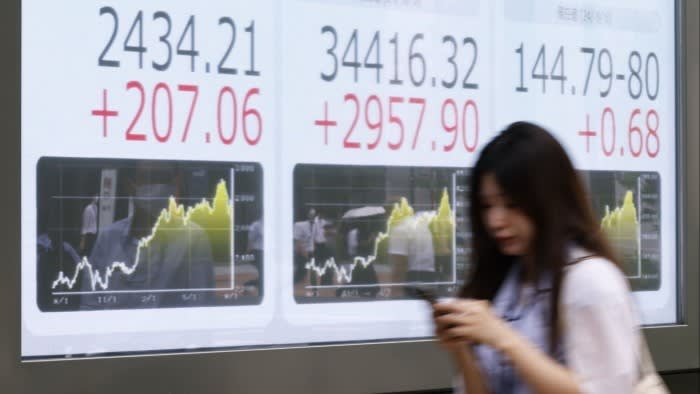Japan stocks climb as Wall Street powers rebound

Unlock the Editor’s Digest for free
Roula Khalaf, Editor of the FT, selects her favourite stories in this weekly newsletter.
Japanese stocks opened strongly on Friday, taking their momentum from the overnight surge on Wall Street and bringing an upbeat end to one of the most turbulent weeks in Tokyo market history.
The broad Topix index rose about 1.5 per cent in the first hour of trading on Friday, matched by similar gains in the narrower Nikkei 225. The yen, whose rapid surge played a central role in Monday’s crash in Tokyo shares, traded relatively calmly at about Y147.2 against the dollar.
On Thursday, US equities posted their strongest daily gain since November 2022 as a drop in US unemployment claims helped to soothe fears over an imminent economic slowdown.
Concerns around the US economy remain the overwhelming driver of sentiment, traders said. A week earlier, a more negative-looking jobs report stoked recession fears and helped trigger the massive, record-breaking sell-off in Tokyo on Monday that wiped 12 per cent off the major Japanese stock indices.
On Tuesday, with brokers able to convince investors that the sell-off had been wildly overdone, shares rebounded with their biggest one-day gain since 2008. By lunchtime on Friday, the Topix had sufficiently recovered to be only 1.5 per cent lower on the market close a week earlier.
Overnight, the benchmark S&P 500 share gauge rose 2.3 per cent, closing out its best day in almost 21 months, while the technology-heavy Nasdaq Composite added 2.9 per cent — its biggest daily gain since February. The rally has helped retrace some of the losses suffered through this week’s steep sell-off.
The advances follow data on Thursday showing that new US applications for unemployment aid — seen as a proxy for job cuts — had fallen to their lowest level in a month. This brought relief to investors after weaker than expected payroll figures last Friday triggered sharp selling across equity markets.
“It was the jobs report last week that sent markets into a tailspin,” said Kristina Hooper, chief global strategist at Invesco, so “it makes sense it was a labour market point that would calm markets” this week.
Figures from the US labour department on Thursday gave a reading of 233,000 for initial state unemployment claims in the week ending August 3 on a seasonally adjusted basis, down from the previous week’s upwardly revised level of 250,000 — and below economists’ forecasts of 240,000.
By contrast, last week’s payrolls report showed the world’s biggest economy added just 114,000 jobs in July, far fewer than consensus predictions of 175,000 — sending share prices sharply lower in volatile trading on Friday and Monday, and triggering a steep rally in government bonds as investors cranked up their bets that the Federal Reserve would need to cut interest rates imminently.
The Vix index of expected US stock market turbulence, known as Wall Street’s “fear gauge”, had briefly topped a reading of 60 on Monday, well above its long-term average of about 20, before retreating.
That gauge of volatility sat at roughly 24 on Thursday, but the day’s share gains still left the S&P about 2.3 per cent off its week-ago close.
For Tim Murray, multi-asset strategist at T Rowe Price, the unemployment report was “a big positive surprise after we’ve seen this run of negative surprises”.
Invesco’s Hooper pointed to an “ongoing process of healing — but with the caveat that markets are going to be on edge because nothing has changed with the Fed. They are not going to do any kind of rate cut before the September meeting.”
“I think it’s going to take time for markets to normalise but we have to ask ourselves what triggered that sell-off, and I think it was irrational,” she added. “I don’t think it’s telling us that we have a big recession coming.”
Equities had until recently had a particularly strong run, driven by hopes of a “soft landing” whereby the Fed successfully brings down inflation without triggering a recession, and by enthusiasm for artificial intelligence companies.
Murray noted that chipmaking giant Nvidia’s second-quarter earnings are due out later this month. Those figures “always have read-throughs for the broader AI infrastructure complex”, he noted. “That might be something that really supercharges the market.”
“But even then, I would be surprised if that happened. It’s more likely we’re back to a slow grind up. And if we have some negative data points along the way, then it could easily move back down very quickly.”
Source link




